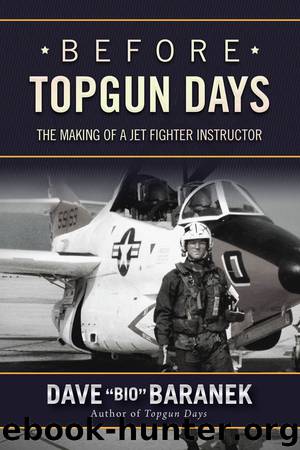Before Topgun Days: The Making of a Jet Fighter Instructor by Dave Baranek

Author:Dave Baranek [Baranek, Dave]
Language: eng
Format: epub
Publisher: Skyhorse Publishing
Published: 2016-03-14T23:00:00+00:00
_________________
* At the time I visited, Buckley was an Air National Guard Base. It later became an Air Force Base, which is its status in 2016.
ELEVEN
Dogfights in Afterburner
In February we could look ahead just a few months and see the end of our time in the RAG. I’d been at Miramar since July but it felt like I had just started. The fundamental training was done; now we would be learning tactics. It started with realistic radar intercepts and progressed to maneuvering dogfights that would teach us the basics of using the Tomcat’s weapons system as we would in aerial combat. RIOs and pilots had gotten a dose of this in our training squadrons, but those flights were pretty basic. Now we were flying a much more complex aircraft on more realistic missions. Not as challenging as what I would soon fly in the Fleet, but they would be among the most stressing missions I had yet flown.
In the simulators and T-39s in Pensacola we used radars designed in the late 1950s. The radar showed a contact as nothing more than a hyphen, and we had to watch its movement and interpret arcane symbols, such as a circle with a gap to indicate the rate of closure, to calculate the situation and direct our aircraft to intercept. We learned to maneuver into position for launching early air-to-air missiles with limited performance. For me, this took a great deal of concentration and training, but it led to a solid understanding of concepts such as lateral separation, turning room, closure rates, and so on, all of which apply to almost every aspect of aerial combat.
In the F-14 I found myself operating a radar designed in the late 1960s. Yes, it was already more than ten years old, but given delays in aircraft design and production it was state-of-the-art in many ways. The Tomcat’s AWG-9 radar could scan a much larger wedge of the sky in front of us and could detect targets at much greater range. Instead of the twenty miles’ separation we normally started with in Pensacola, we now routinely started thirty or forty miles apart, and the radar could see aircraft more than 100 miles away. We were like kids with a new bike; we even made a word out of AWG-9. Like the first part of “August,” to us it was the “awg 9.”
The AWG-9 also had different modes that made it better at detecting targets over land, where we would expect to engage enemy fighters in many combat scenarios. In Pensacola we ran intercepts only over the Gulf of Mexico, which was fine for early training. At Miramar we trained over the Pacific Ocean, but also over ranges in southern California and southwestern Arizona near Yuma. The rough terrain added spurious returns known as “clutter” to the radar scope in certain modes, while other modes eliminated the clutter but had their own shortcomings.*
One welcome improvement was that the AWG-9 showed a digital readout of altitude, speed, heading, and other data about the targets.
Download
This site does not store any files on its server. We only index and link to content provided by other sites. Please contact the content providers to delete copyright contents if any and email us, we'll remove relevant links or contents immediately.
| Airport | Commercial |
| Helicopters | History |
| Pictorial | Piloting & Flight Instruction |
| Repair & Maintenance |
Small Unmanned Fixed-wing Aircraft Design by Andrew J. Keane Andras Sobester James P. Scanlan & András Sóbester & James P. Scanlan(32141)
Navigation and Map Reading by K Andrew(4554)
Endurance: Shackleton's Incredible Voyage by Alfred Lansing(3845)
Wild Ride by Adam Lashinsky(1659)
And the Band Played On by Randy Shilts(1615)
The Box by Marc Levinson(1595)
Top 10 Prague (EYEWITNESS TOP 10 TRAVEL GUIDES) by DK(1567)
The Race for Hitler's X-Planes: Britain's 1945 Mission to Capture Secret Luftwaffe Technology by John Christopher(1526)
The One Percenter Encyclopedia by Bill Hayes(1463)
Girls Auto Clinic Glove Box Guide by Patrice Banks(1363)
Trans-Siberian Railway by Lonely Planet(1345)
Looking for a Ship by John McPhee(1320)
Batavia's Graveyard by Mike Dash(1302)
Fighting Hitler's Jets: The Extraordinary Story of the American Airmen Who Beat the Luftwaffe and Defeated Nazi Germany by Robert F. Dorr(1301)
Troubleshooting and Repair of Diesel Engines by Paul Dempsey(1284)
Bligh by Rob Mundle(1274)
TWA 800 by Jack Cashill(1253)
The Great Halifax Explosion by John U. Bacon(1229)
Ticket to Ride by Tom Chesshyre(1229)
